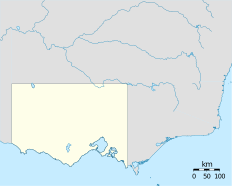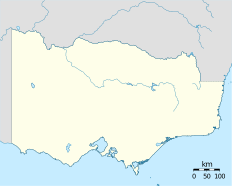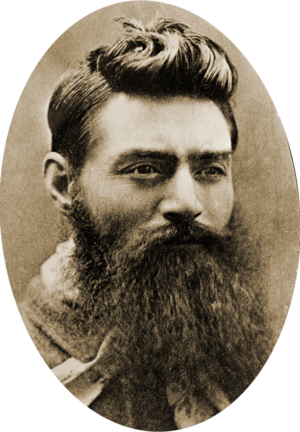History of Victoria facts for kids
This article tells the story of Victoria, a special part of Australia. It was once a British colony and is now a state.
Before 1851, Victoria was part of New South Wales. From 1851 to 1901, it was known as the Colony of Victoria. It had its own government but was still part of the British Empire. In 1901, Victoria became a state in the new Commonwealth of Australia.
Contents
- Ancient Aboriginal History in Victoria
- Early European Explorers Arrive
- First British Settlement in 1803
- Growing Interest in Bass Strait's North Coast
- Permanent European Settlement in 1834
- Victoria Becomes a Separate Colony
- The Gold Rush of the 1850s
- Victorian Colonial Politics
- The Famous Kelly Gang
- The Depression of 1893
- Victoria Joins the Australian Federation in 1901
Ancient Aboriginal History in Victoria
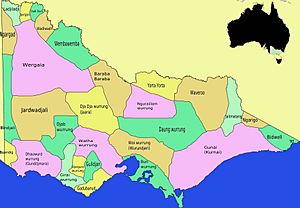
Victoria was originally home to many Aboriginal nations. They lived on this land for thousands of years. Experts like Gary Presland believe Aboriginal people have been in Victoria for about 40,000 years. They lived by fishing, hunting, gathering plants, and even farming eels.
At the Keilor Archaeological Site, scientists found an old fireplace in 1971. It was about 31,000 years old! This makes Keilor one of the oldest places where humans lived in Australia. A skull found there is between 12,000 and 14,700 years old.
Other ancient sites in Tasmania and the Bass Strait Islands are 20,000 to 35,000 years old. Back then, sea levels were much lower. This allowed Aboriginal people to walk across southern Victoria and a land bridge to Tasmania.
Around 20,000 years ago, during the Ice Age, the area that is now Port Phillip Bay was dry land. The Yarra and Werribee rivers joined and flowed through this dry plain to the ocean. Tasmania and the Bass Strait islands became separate from mainland Australia about 12,000 years ago. This happened as sea levels rose. Port Phillip Bay filled with water between 8,000 and 6,000 years ago.
Old stories from the Wada wurrung, Woiwurrung, and Bun wurrung people describe how the bay was flooded. Hobsons Bay was once a place where kangaroos were hunted. Some stories say that Bunjil created the bay. Others say it was flooded when the Yarra River was formed.
Early European Explorers Arrive
In 1770, Lieutenant James Cook sailed his ship, HM Bark Endeavour, from New Zealand. He saw land at Point Hicks, west of Gabo Island. He then sailed east and north, exploring the coast of Australia.
Ships sailing from Great Britain to Sydney would go around Van Diemen's Land (now Tasmania). They wondered if the water between Van Diemen's Land and New South Wales was a large bay or a strait.
To find out, Governor John Hunter sent George Bass to explore the coast in a small boat. In January 1798, Bass reached Wilsons Promontory and Western Port. Bad weather made him return to Sydney. Bass came back in December 1798 with Matthew Flinders in the ship Norfolk. They sailed through the strait, proving it existed.
In December 1800, Lieutenant James Grant sailed HMS Lady Nelson through Bass Strait. Governor King was not happy with Grant's map, so he sent him back to map the strait better. Grant could not go past Western Port due to bad weather. He stayed there for five weeks, planting crops on Churchill Island near Phillip Island.
In January 1802, Lieutenant John Murray on Lady Nelson visited Western Port. He entered Port Phillip on February 14. He named Arthur's Seat and explored Corio Bay. He officially claimed the bay for Britain, naming it Port King.
Three weeks later, French explorer Nicolas Baudin sailed through the strait. He was the first to properly map the western coast. In April 1802, another French ship, Le Naturaliste, explored the area around French Island. They named it Ile des Français, which means "Island of the French."
On April 26, 1802, Flinders, not knowing about Murray's visit, entered Port Phillip in Investigator. He climbed Arthur's Seat and explored the area.
In January 1803, Acting-Lieutenant Charles Robbins sailed all around Port Phillip in HMS Cumberland. With him were surveyor Charles Grimes and others. They found a river at the top of the bay. They followed the western branch, which they called the Saltwater River (now Maribyrnong River). Then they followed the eastern branch, the freshwater Yarra, to Dights Falls. They met local Aboriginal people in a friendly way. They thought the best place for a settlement was at the northern end of the bay, but they didn't think the soil was good for farming.
First British Settlement in 1803
Britain was fighting in the French revolutionary wars. Governor King worried that Bass Strait could hide enemy ships. He also thought it could be an important trade route. The French ships exploring the area made him even more concerned. King also needed a new place for the growing number of convicts in Sydney. Port Phillip seemed like a good spot with its good climate and resources.
News of Murray's and Flinders' discoveries reached England. In February 1803, Lord Hobart decided to send a ship of convicts to Port Phillip instead of Sydney. On April 24, 1803, HMS HMS Calcutta, with Lieutenant-Colonel David Collins leading the group, left England. The ship Ocean also came along. There were 402 people, including 307 convicts. One of the children was eleven-year-old John Pascoe Fawkner, who later helped found Melbourne.
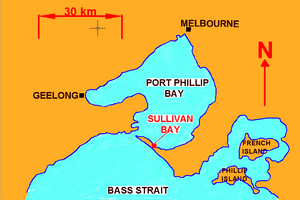
The group entered Port Phillip on October 9, 1803. They chose a spot at Sullivan Bay, near what is now Sorrento.
Collins was soon unhappy with the area. Explorers reported strong currents, sandy soil, poor timber, swampy land, and little fresh water. They also had a conflict with the Wathaurung people near Corio Bay, killing their leader. This was the first known killing of Aboriginal people by settlers in Victoria.
Collins told Governor King about his concerns. King agreed and suggested moving the settlement. In January and May 1804, the group moved to Hobart, a new settlement in Van Diemen's Land (Tasmania).
The short settlement at Sorrento didn't achieve much. Collins has been criticized for not exploring the bay more thoroughly, especially the northern part with its freshwater river. The site of the settlement is now a park with four graves from that time.
When Collins left, some convicts who had escaped were left behind. Most were thought to have been killed by Aboriginal people. However, William Buckley survived. He lived with the Wathaurong people for 32 years. In 1835, he met Europeans again.
For the next 30 years, only a few sealers and whalers visited the southern coast of New South Wales.
Growing Interest in Bass Strait's North Coast
After some explorations south from New South Wales, Hamilton Hume and William Hovell set out in October 1824. They crossed the Murray River (which they called the Hume River) near Albury. They continued south, crossing the Goulburn River (which they called the Hovell). They reached Corio Bay, thinking it was Western Port. They returned to Sydney in January 1825, praising the land they had seen.
In April 1826, French explorer d'Urville visited a sealer's camp on Phillip Island. Governor Darling worried about this French interest. Because of Hume and Hovell's reports, he ordered a settlement at Western Port. A small group of convicts arrived in November 1826 at Corinella. Hovell, who was with them, realized this was not where he had been before. He reported that the land around Western Port was swampy. The settlement was abandoned in April 1828.
Settlers in Van Diemen's Land were interested in the land across Bass Strait. This was due to Hume and Hovell's reports and stories from sealers. John Batman and John Wedge planned an expedition in 1825 but were not allowed. Governor Darling refused many requests for land over the next few years.
A sealer named William Dutton built a hut at Portland Bay in 1829.
The expedition down the Murray River by Charles Sturt in 1830 again sparked interest in southern settlement. In April 1833, Edward Henty visited Portland and was very impressed. In November 1834, John Hart, another sailor, spoke highly of Western Port. It was clear that settlement would happen soon.
In June 1834, banker Charles Swanston told his client George Mercer that land was scarce in Van Diemen's Land. He suggested investing across Bass Strait. In August 1834, a group of eight wealthy people from Launceston formed the Port Phillip Association. On November 19, 1834, Edward Henty landed at Portland Bay. This was the first lasting European settlement on the north coast of Bass Strait.
Permanent European Settlement in 1834
Victoria's first successful British settlement was at Portland. The Henty family, farmers from Van Diemen's Land (Tasmania), settled there on November 19, 1834. When Major Thomas Mitchell explored the region from Sydney in 1835, he was surprised to find a small, thriving community at Portland in August 1836. They were doing well from the fertile farmland.
How Victoria's Borders Were Set
The District of Port Phillip was officially created in September 1836. It was part of New South Wales but its exact borders were unclear. In 1839, the district was defined. It included all lands in New South Wales south of 36°S latitude, between 141°E (the border with South Australia) and 146°E longitude. In January 1840, the district expanded north to the Murrumbidgee River. However, after many complaints from Sydney, the border was moved back south to the Murray River.
Elected representatives for Port Phillip and Melbourne had to travel to Sydney for meetings. This made them feel far away from the people they represented. To protest and push for independence, people in Port Phillip did not nominate candidates for the 1848 election. Instead, for the Town of Melbourne, they put forward Earl Grey, a British government official. Grey received almost 75% of the votes, even though he had never visited Australia and couldn't be a member of the British Parliament.
The fight for independence continued. This led Earl Grey to introduce a law in the British Parliament. This law, the Australian Colonies Government Act 1850, separated the District of Port Phillip from New South Wales. It became the Colony of Victoria on July 2, 1851. The borders from 1843 are still the borders of the modern State of Victoria. This law also gave each colony its own government.
Conflicts Over Land and Resources
When European settlers started sheep farms, Aboriginal people were forced off their lands. This led to conflicts over resources and land use. One sad event was the Convincing Ground massacre in Portland Bay in 1833 or 1834. It may have started over a beached whale between whalers and the Kilcarer gundidj clan of the Gunditjmara people.
Melbourne was founded in 1835 by John Batman. It quickly grew, but this came at a great cost to the original Aboriginal people. Wealthy settlers, land buyers, and their workers arrived from 1835. They rushed to claim land they saw as "empty." The British Crown and colonial governments did not recognize that Aboriginal people owned their lands and waters. Even though they said Aboriginal people were protected by law, this protection often failed.
In early 1836, a settler named Mr. Franks and his shepherd were found dead. Their station was near Cotterill's Mount (now called Sugarloaf). George Smith found them and gathered a group to investigate. This group, guided by a member of the Melbourne tribe, found a camp of the Indigenous Wathaurong tribe. An unclear event happened there. While some reports said no harm was done to the Aboriginal people, Wathaurong stories say 35 of their people were killed in revenge. This event is now known as "The Mount Cottrell massacre."
Between 1836 and 1842, Aboriginal groups in Victoria lost land larger than England. Even though five "Aboriginal Protectors" were appointed in 1839, their work was difficult. The government's policy allowed settlers to take Aboriginal land. This explains why many original inhabitants of Port Phillip's grasslands died soon after 1835. By 1845, fewer than 240 wealthy Europeans held all the farming licenses in Victoria. These families gained much political and economic power for generations.
Two Tasmanian Aboriginal men, Tunnerminnerwait and Maulboyheenner, were the first people executed in the Port Phillip District. This happened in 1842. They were publicly hanged for murder. A public marker now stands near the site of their execution in Melbourne.
A big financial crisis happened in 1842–43. The government asked banks for high interest rates on money from land sales. Banks then charged their customers even higher rates for loans. Land prices dropped sharply. Many people lost everything. Unemployment grew, wages and prices fell, and many businesses went bankrupt.
Victoria Becomes a Separate Colony
The first request for the Port Phillip District to separate from New South Wales was made in 1840. Henry Fyshe Gisborne wrote it and gave it to Governor Gipps. Gipps had supported separation before, but he rejected this request.
However, settlers in Port Phillip kept pushing for separation. This led to the Port Phillip District becoming a separate colony on July 1, 1851. The British law that separated Port Phillip and named the new colony "Victoria" (after Queen Victoria) was signed by the Queen on August 5, 1850. The New South Wales government passed a law to make this happen on July 1, 1851. This was the official start of the Colony of Victoria. Charles La Trobe became the new colony's first Lieutenant-Governor.
In 1851, Victoria's European population was only 77,000. Only 23,000 people lived in Melbourne. Melbourne was already a major center for Australia's wool trade.
The Gold Rush of the 1850s
In 1851, gold was first found in Clunes and Buninyong near Ballarat. More gold was found later at Bendigo and many other places across Victoria. This started one of the biggest gold rushes in the world! The colony quickly grew in population and wealth. In just ten years, Victoria's population jumped from 76,000 to 540,000.
Many gold records were set, including the "richest shallow goldfield in the world." The Welcome Stranger was the largest gold nugget ever found. Between 1851 and 1860, Victoria produced 20 million ounces of gold. This was one-third of all the gold found in the world at that time!
People came from all over the world to find gold. Many came from the British Isles, especially Ireland. Many Chinese miners also worked in Victoria. Their history is still strong in Bendigo. While there was some racism against them, it was not as violent as the anti-Chinese riots in New South Wales. However, there was a riot at Buckland Valley near Bright in 1857. Conditions on the goldfields were crowded and dirty. A typhoid outbreak at Buckland Valley in 1854 killed over 1,000 miners.
In 1854, miners rebelled against the Victorian government. They were protesting against mining taxes. This event is known as the "Eureka Stockade." British troops crushed the rebellion. However, some of the rebellion's leaders later became members of the Victoria Parliament. The Eureka Stockade is seen as a very important moment in the development of Australian democracy.
Victorian Colonial Politics
In 1857, Victoria had its first Catholic government leaders in the British Empire. John O'Shanassy became Premier, and Charles Gavan Duffy was his deputy. This showed the growing number of Irish immigrants.
In 1862, Duffy tried to pass a Land Act. It aimed to break the land-holding power of the "squatter" class. But it failed. In 1871, Duffy opposed Premier Sir James McCulloch's plan for a land tax. Duffy argued it was unfair to small farmers. He then briefly became Premier himself from June 1871 to June 1872.
Victoria's first military action outside its borders was sending troops and a warship to New Zealand. This was part of the New Zealand Wars.
The Famous Kelly Gang
From 1878 to 1880, Victoria was the scene of the famous bushranger Ned Kelly and his gang. Historian Geoffrey Serle called Kelly and his gang "the last example of lawlessness in a society that was becoming very organized." After his execution in Melbourne in 1880, Ned Kelly became a cultural icon. He has inspired many books, movies, and artworks. More biographies have been written about him than any other Australian.
The Depression of 1893
The 1880s were a time of great wealth in Victoria. People invested a lot of money from England in land and buildings. Many companies and banks rushed to get a share of this money. About £40,000,000 flowed into Victoria in six years. This led to a false sense of prosperity. Banks printed millions of pounds in notes, and trade boomed.
But this boom ended quickly. People lost trust in the banks. A "run" on the banks began, meaning many people tried to withdraw their money at once. This caused widespread disaster.
In 1893, 14 banks failed. Twelve of these banks had 905 branches across Australia. They owed £166,000,000. Thousands of people lost everything they owned. Bank notes became worthless. Victoria faced a very deep financial depression. Many people lost their jobs. Wages and prices dropped, and many businesses went bankrupt. The government also had to make big cuts.
Victoria Joins the Australian Federation in 1901
At the start of 1901, Queen Victoria made an official announcement. Victoria stopped being an independent colony and became a state in the Commonwealth of Australia. Politicians from Victoria and Tasmania played a big part in the process of Federation.
Because of the gold rush, Melbourne became the financial center of Australia and New Zealand. From 1901 to 1927, Australia's Parliament met in Melbourne while Canberra was being built. At that time, Melbourne was also the largest city in Australia. It was the second largest city in the British Empire after London.


